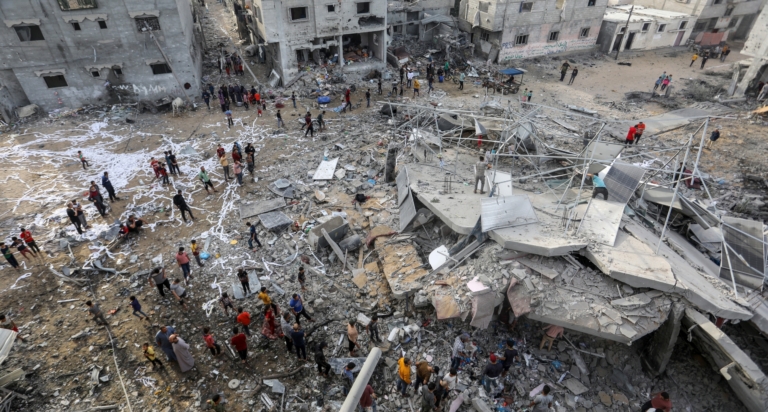
Six months have passed since Hamas launched a surprise attack on Israel on October 7, 2023, precipitating the latter’s devastating war on the Gaza Strip that by latest count has killed some 34,000 Palestinians, destroyed much of the Strip’s buildings and infrastructure, and displaced the entire population. The Israeli siege of the Strip has also precipitated different levels of famine and starvation of Gaza’s civilians, while military commanders have wantonly destroyed all schools and universities and ruined or damaged much of the healthcare system. Today, the southern city of Rafah—home to about 1.5 million residents and refugees—is in the eye of the storm as Israel’s war cabinet threatens to invade it in a purported effort to defeat Hamas and end it as a fighting force.
Like similar situations of conflict, the Israeli war on Gaza has different dimensions and angles. From the devastation inside Gaza to the impact on Palestinian politics and national liberation, and from possible regional repercussions to long-term implications for international law and legitimacy, the war will arguably prove to be a seminal event in global politics, order, and rules. Most importantly, and considering both the international community’s seeming split between those eager to uphold Post-WWII international laws and conventions and those supporting Israel’s continuing and lawless assault on Gaza, the war is very likely to produce a new push for recasting international politics away from the American-led so-called rules-based order.
Arab Center Washington DC (ACW) asked its fellows and associates to look at and comment on different aspects of the Israeli war on Gaza six months after it commenced. Their responses are below.
Table of Contents:
- The Palestine Question: Quo Vadis?
- The Arab World’s Stand on Gaza Is One of Weakness and Risk Aversion
- In Gaza, a Human-Made Catastrophe Beyond Comprehension
- No Accountability for Israel Has Turned Digital Spaces into Sites for Informal Justice
- What Is Asked of the Biden Administration Now?
The Palestine Question: Quo Vadis?
Khalil E. Jahshan, ACW Executive Director
As the conflict in the Gaza Strip marks the end of its sixth month of aimless and brutal bloodletting resulting in shocking and unprecedented numbers of civilian casualties, the time has come for both parties, Israelis and Palestinians, to answer the tough question they have been eluding since October 7, i.e., where do we go from here?
The unforeseen Hamas attack on Israeli military and civilian presence in the Gaza corridor did shock Israeli society to its core and threw the whole country off balance; however, it did not end Israeli occupation or enhance the prospects for independent Palestinian statehood. Similarly, Israel’s pursuit of “complete victory” by waging vengeful war on the people of Gaza has demonstrably failed to achieve its military objectives primarily because it pertains to a political problem begging for a political solution.
The conflict has consequently entered a phase of total stalemate characterized by a zero-sum mindset that could last indefinitely, threatening all parties in the Middle East, participants and bystanders alike, with ominous long-term consequences.
With 33,667 Palestinians dead, 75,933 injured, more than 8,000 missing, 56 percent of buildings in Gaza destroyed or damaged resulting in the displacement of 1.7 million people facing deliberate man-caused starvation, Palestinians in the Strip and beyond are beginning to ponder where the Palestine question stands today. Reflecting this national fear among his people, Palestinian lawyer, writer, and human rights activist Raja Shehadeh warned in the Guardian on April 9, 2024, that after six months of war, the Palestinians “may lose Palestine completely.”
Whether intended to do so or not, October 7 and its fallout quickly evolved into a transformative event that produced a radical change in the character and outlook of the Arab-Israeli conflict, in general, and the Palestine question, in particular. The initial attack and the subsequent war unleashed by Israel throughout the Gaza Strip and the West Bank altered the focus of the conflict, its intensity, and its trajectory to the point where neither side has the option anymore of resuming the status quo ante or resort to the old rules of the game as they existed on October 6.
Consequently, Palestinian leaders, in all of their political shades, are forced to adjust to this new phase of their conflict with Israel by, first and foremost, putting aside their political differences and immediately pursuing a united front in the form of a functional governing arrangement conducive to securing the future of their cause against a more aggressive enemy determined to blunt their national aspirations, once and for all. To do so, all Palestinian factions must endorse a common agenda focused on ending the carnage in Gaza, a feasible plan for the reconstruction of the decimated territory, and a restructuring of the political system in Palestine to include both the West Bank and the Gaza Strip jointly governed by a democratically elected government capable of leading the Palestinian people out of their current political, economic, and moral predicament. The recent appointment of a “new and reform-oriented” government in Ramallah might be satisfactory to external powers seeking to determine the road map for Palestine “the day after,” but that clearly falls short of fulfilling the national aspirations of a people determined and equipped to achieve political independence from Israeli occupation and domination.
The Arab World’s Stand on Gaza Is One of Weakness and Risk Aversion
Imad K. Harb, ACW Director of Research and Analysis
Aside from calls for an immediate ceasefire and donations of humanitarian assistance that has not reached the needy in Gaza, the Arab world has dealt with the war on the Strip from a position of weakness and avoidance of risk originating in most of its states’ dependence on the United States and unresponsiveness to public opinion and preferences. The combination of weakness and risk aversion has produced ineffective collective action to force a change in Israeli policy and behavior and an almost complete absence from diplomatic efforts to stop the ongoing carnage in Gaza. Arguably no one in the Arab world—and throughout the community of nations—expected Arab armies to march to defend Palestinians from massacres, famine, and genocide, but that was exactly what transpired: Arab military institutions felt no urge to come to the rescue of the Palestinians. To be sure, Israel and the United States have been the most important influencers of developments in Gaza since the October 7 Hamas attack on Israel.
Qatar and Egypt have spearheaded the Arab world’s diplomatic efforts to reach a ceasefire in Gaza, release Israelis in Hamas and other Palestinian factions’ custody, free thousands of Palestinians in Israeli prisons, and allow humanitarian relief to reach Gazans. Thus far, their only success was to arrange for a short-term truce last November during which prisoners were exchanged. But efforts since have failed to produce similar results. The involvement of Jordan, Morocco, and the other Gulf countries was circumscribed by their relations with the United States, Israel’s most ardent supporter and supplier of arms. Other states—Libya, Sudan, and Syria—have been consumed by their domestic troubles and concerns, while Iran-friendly militias in Iraq, Lebanon, and Yemen took it upon themselves to attack and harass Israeli and American forces, but to no discernible outcome thus far.
By not being effective actors in preventing the ongoing genocide in Gaza, most Arab states have ignored the overwhelming support Palestinians and the Palestine cause enjoy among Arab masses; a fact borne out by the latest Arab Opinion Index that measured the Arab public’s position on the war in Gaza. Ignoring this public’s feelings about the righteousness of the Palestine cause and the failure of schemes to normalize relations with Israel, most Arab regimes have yet again proven their unrepresentativeness of the overwhelming majority of their citizens and, indeed, their illegitimate and undemocratic rule. As the genocide in Gaza continues, and as the Arab world sits almost in complete silence about Israeli atrocities, the war in the Strip is likely to be yet another harbinger of change that sooner or later will create a new Arab political order.
In Gaza, a Human-Made Catastrophe Beyond Comprehension
Yara M. Asi, ACW Non-resident Senior Fellow
In just six months, the world has witnessed—and in many cases, justified and funded– a human-made catastrophe beyond comprehension. The images of death, disablement, and destruction from the Gaza Strip have been constant, and videos have captured that which images cannot. Yes, Gaza is suffering a humanitarian crisis, but the term seems insufficient for the scale of human suffering that has been purposefully inflicted on a civilian population, half of which are children.
Perhaps the most emergent and pressing crisis is that of famine, a state of food deprivation that cannot occur without policies that ensure that it can. Aside from imposing a siege that has limited the amount of food and other aid that can be distributed, as well as where it can be distributed, Israel has also bombed or otherwise destroyed markets, bakeries, food production facilities, agricultural lands, and even aid convoys where hungry Palestinians lined up to get bags of flour. In February 2024, the Integrated Food Security Phase Classification (IPC), the global food security warning initiative, found that Gaza already reported the “highest share of people facing high levels of acute food insecurity that the IPC initiative has ever classified.” It warned of further deterioration without an immediate ceasefire, which, to date, does not appear likely. Already, humanitarian agencies have reported dozens of cases where children have died from starvation, and the given numbers are likely underestimated due to lack of data.
Aside from starvation, Palestinians are facing a completely collapsed health system, without the ability to adequately attend to basic needs. Trauma care is often given without proper tools and conditions, resulting in excess amputations due to the inability to treat wounds. More than 1,000 children, some under the age of 1, have already lost at least one limb. Pregnant women have been giving birth in unsanitary conditions, often without anesthesia, and babies are unable to receive adequate post-natal care. Rates of miscarriage and stillbirth are estimated to have increased by 300 percent. Those with other health needs, such as people with cancer, cardiovascular disease, and diabetes, have gone months without needed medications or procedures. Even if there is a ceasefire tomorrow, the ramifications of the complete decimation of Gaza’s health system will be felt for lifetimes.
Multiple humanitarian agencies with extensive experience working across fragile settings have reported that the crises in Gaza surpass what they have ever seen. These conditions have played a significant role in South Africa’s genocide case against Israel before the International Court of Justice, where South Africa’s lawyers have argued that these conditions exist precisely because they were created—by forcing displacement, restricting movement, preventing aid, and destroying entire sections of Gaza so that they are uninhabitable. As stated by UN Secretary-General António Guterres, “The nightmare in Gaza is more than a humanitarian crisis. It is a crisis of humanity.”
No Accountability for Israel Has Turned Digital Spaces into Sites for Informal Justice
Tamara Kharroub, ACW Deputy Executive Director and Senior Fellow
Most western mainstream media outlets (print and television alike) demonstrably adopted an extreme bias that favored Israeli official and military narratives and propagated anti-Palestinian racism and dehumanization in the first few weeks immediately following Hamas’s October 7 attack and Israel’s indiscriminate war on the Palestinians in Gaza. That was accompanied by systematic Israeli attempts to silence Palestinian narratives and manufacture consent for the war through the targeting of Palestinian journalists and their families in Gaza, banning western journalists from reporting from Gaza, only allowing reporters to be accompanied by the Israeli military, and requiring review of footage before broadcast. Recently, Israel took steps to ban Aljazeera which is perhaps the only English-language media organization reporting from Gaza. Additionally, the Israeli government has been orchestrating propaganda operations via media talking points and social media campaigns to whitewash the atrocities it commits in Gaza.
But it didn’t take long before the images of devastation began emerging from the Strip, as Palestinian journalists and content creators risked their lives to document and portray their suffering, humanity, and pleas for ceasefire. The horrors from Gaza and the images of death and destruction continue to flood social media platforms despite widespread and documented censorship and shadow banning of Palestinian content by social media companies especially Meta and more recently TikTok. Meanwhile, videos of Israeli soldiers looting homes in Gaza and boasting about killing Palestinian children, and Israelis mocking Palestinian suffering, have become popular genres on social media channels.
The extreme nature of the violence and the power disparity, coupled with gross media bias and failure to investigate and push back against Israeli claims by mainstream media outlets, have triggered an online movement of informal justice, a process some scholars have referred to as “trial by Internet.” The biased reporting on the war and the lack of accountability for Israeli crimes have generated doubt about the credibility of both the media coverage and the formal justice system and rule-based international order. Social media users around the world took it upon themselves to act as reporters and detectives; to investigate, scrutinize, and fact-check Israeli official claims and videos (such as the famous “list” and fake nurse videos, among many others), to highlight Palestinian voices and disseminate images from Gaza, and name and shame media outlets and journalists for their biased reporting and their dehumanization of Palestinians.
In this way, social media platforms have created spaces for informal justice, which ultimately impacted media coverage and official discourse. The people’s digital court has offered spaces to contest the dominant mainstream narratives, counter the traditional power and gatekeeping structures, and challenge global injustices, particularly in dealing with Palestine. With the inefficiencies of formal justice processes, digital spaces have also acted as alternative avenues for informal justice and accountability. While social media spaces have their limitations and they cannot replace the formal justice systems, they can certainly help document evidence, mobilize for accountability, and exert pressure on decision makers.
This significant shift in engaging with the media environment, especially among young people in the West, will likely lead to a momentous change in the information landscape. Just as the war has exposed the hypocrisy and double standards of western nations and will have wider long-lasting repercussions for the application of international law, it will also have important implications for the future of the media and information ecosystems well beyond this moment and well beyond Gaza.
What Is Asked of the Biden Administration Now?
Yousef Munayyer, ACW Director of Palestine/Israel Program and Senior Fellow
For six months the Biden administration has backed the Israeli government and its military to the hilt as it blatantly violated just about every known law or principle relating to the conduct of war. Israeli forces routinely targeted the civilian infrastructure in the Gaza Strip, killed protected individuals—from medics to journalists to aid workers—in record numbers, displaced the entire population, and used starvation as a weapon of war. Despite all of this, the Biden administration has been unwavering in its support for Israel’s criminality in Gaza.
This may have begun to change in recent weeks after the killing of 6 western aid workers with the World Central Kitchen (WCK) and their Palestinian driver in an Israeli strike on a three-car humanitarian aid convoy. The convoy strike might be a turning point not only because Israel’s killing of westerners is harder to defend in the West where the dehumanization of Palestinians is rampant, but also because WCK was in Gaza as the Biden administration tolerated Israel’s demands and behavior around aid. Israel did not want to be responsible for assisting the civilian population in Gaza, nor did it want the primary agency with the capacity for doing so, UNRWA, to be able to operate.
For months, the Biden administration acceded to these Israeli demands. To do so, the administration was even willing to airdrop aid and build a temporary pier on the Gaza shore for the offshore delivery of aid because Israel was not permitting it via normal aid land crossings. In other words, the World Center Kitchen workers were there precisely because the Biden administration was willing to tolerate Israel’s refusal to allow other forms of relief, thus necessitating inefficient workarounds. The Israeli killing of the aid workers, in a targeted fashion, added insult and injury to a Biden administration that was bending over backwards to accommodate Israel’s preferences despite international legal obligations. For whatever reason, perhaps because of global outrage or the continually turning domestic atmosphere in the United States, President Biden seems to have seen enough to at least begin to shift when it comes to the humanitarian aid policy. Why it took over 33,000 Palestinian deaths, malnutrition of hundreds of thousands of Palestinians, and a famine to finally stir the President’s conscience even this little bit following six months of genocide is another question altogether.
The views expressed in this publication are the author’s own and do not necessarily reflect the position of Arab Center Washington DC, its staff, or its Board of Directors.





